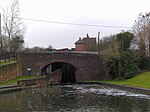Penn Halt railway station

Penn Halt was the smallest of all stops on the Wombourne Branch Line. It was opened by the Great Western Railway in 1925 and closed in 1932. The line was single track and the halt was a single platform. It suffered from poor patronage, as with all the stations on the branch. This may have been, in part, due to the somewhat strange positioning of the station by the GWR, several miles from the nearest settlement. All that remains is a lot of bushes and a sign stating where the halt once was. This is now part of the South Staffordshire Railway Walk which covers the trackbed from Tettenhall railway station to Gornal Halt railway station.
Excerpt from the Wikipedia article Penn Halt railway station (License: CC BY-SA 3.0, Authors, Images).Penn Halt railway station
South Staffordshire Railway Walk, South Staffordshire Lower Penn
Geographical coordinates (GPS) Address Nearby Places Show on map
Geographical coordinates (GPS)
| Latitude | Longitude |
|---|---|
| N 52.5635 ° | E -2.2036 ° |
Address
South Staffordshire Railway Walk
South Staffordshire Railway Walk
WV4 4XS South Staffordshire, Lower Penn
England, United Kingdom
Open on Google Maps




